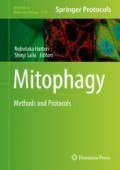Abstract
Mitochondria constitute the main energy-producing centers of eukaryotic cells. In addition, they are involved in several crucial cellular processes, such as lipid metabolism, calcium buffering, and apoptosis. As such, their malfunction can be detrimental for proper cellular physiology and homeostasis. Mitophagy is a mechanism that protects and maintains cellular function by sequestering harmful or dysfunctional mitochondria to lysosomes for degradation. In this report, we present experimental procedures for quantitative, in vivo monitoring of mitophagy events in the nematode Caenorhabditis elegans.
References
Corsi AK, Wightman B, Chalfie M (2015) A transparent window into biology: a primer on Caenorhabditis elegans. Genetics 200(2):387–407
Katarzyna ZR, Suresh S (2016) Autophagic degradation of peroxisomes in mammals. Biochem Soc Trans 44(2):431–440
Oku M, Sakai Y (2016) Pexophagy in yeasts. Biochim Biophys Acta 1863(5):992–998
Cingolani F, Czaja MJ (2016) Regulation and functions of autophagic lipolysis. Trends Endocrinol Metab 27(10):696–705
Kawabata T, Yoshimori T (2016) Beyond starvation: an update on the autophagic machinery and its functions. J Mol Cell Cardiol 95:2–10
Mijaljica D, Devenish RJ (2013) Nucleophagy at a glance. J Cell Sci 126(Pt 19):4325–4330
Khaminets A et al (2015) Regulation of endoplasmic reticulum turnover by selective autophagy. Nature 522(7556):354–358
Suzuki K (2013) Selective autophagy in budding yeast. Cell Death Differ 20(1):43–48
Lemasters JJ (2005) Selective mitochondrial autophagy, or mitophagy, as a targeted defense against oxidative stress, mitochondrial dysfunction, and aging. Rejuvenation Res 8:3–5
Bergamini E (2006) Autophagy: a cell repair mechanism that retards ageing and age-associated diseases and can be intensified pharmacologically. Mol Asp Med 27:403–410
Kim I, Rodriguez-Enriquez S, Lemasters JJ (2007) Selective degradation of mitochondria by mitophagy. Arch Biochem Biophys 462:245–253
Sun N, Youle RJ, Finkel T (2016) The mitochondrial basis of aging. Mol Cell 61:654–666
Redmann M, Darley-Usmar V, Zhang J (2016) The role of autophagy, mitophagy and lysosomal functions in modulating bioenergetics and survival in the context of redox and proteotoxic damage: implications for neurodegenerative diseases. Aging Dis 7:150–162
Tong M, Sadoshima J (2016) Mitochondrial autophagy in cardiomyopathy. Curr Opin Genet Dev 38:8–15
Zhang J (2013) Autophagy and mitophagy in cellular damage control. Redox Biol 1:19–23
Voigt A, Berlemann LA, Winklhofer KF (2016) The mitochondrial kinase PINK1: functions beyond mitophagy. J Neurochem 139:232–239. doi: 10.1111/jnc.13655
Youle RJ, Narendra DP (2011) Mechanisms of mitophagy. Nat Rev Mol Cell Biol 12:9–14
Yamaguchi O et al (2016) Receptor-mediated mitophagy. J Mol Cell Cardiol 95:50–56
Schweers RL et al (2007) NIX is required for programmed mitochondrial clearance during reticulocyte maturation. Proc Natl Acad Sci U S A 104(p):19500–19505
Sandoval H et al (2008) Essential role for Nix in autophagic maturation of erythroid cells. Nature 454:232–235
Melser S et al (2013) Rheb regulates mitophagy induced by mitochondrial energetic status. Cell Metab 17:719–730
Liu L et al (2012) Mitochondrial outer-membrane protein FUNDC1 mediates hypoxia-induced mitophagy in mammalian cells. Nat Cell Biol 14:177–185
Palmisano NJ and Meléndez A. (2016) Detection of autophagy in Caenorhabditis elegans. Cold Spring Harbor Protoc 2016(2):pdb.top070466
Al Rawi S et al (2011) Postfertilization autophagy of sperm organelles prevents paternal mitochondrial DNA transmission. Science 334(6059):1144–1147
Sato M, Sato K (2011) Degradation of paternal mitochondria by fertilization-triggered autophagy in C. elegans embryos. Science 334(6059):1141–1144
Palikaras K, Lionaki E, Tavernarakis N (2015) Coordination of mitophagy and mitochondrial biogenesis during ageing in C. elegans. Nature 521(7553):525–528
Schiavi A et al (2015) Iron-starvation-induced mitophagy mediates lifespan extension upon mitochondrial stress in C. elegans. Curr Biol 25(14):1810–1822
Rosado CJ et al (2008) Rosella: a fluorescent pH-biosensor for reporting vacuolar turnover of cytosol and organelles in yeast. Autophagy 4:205–213
Dudek J, Rehling P, van der Laan M (2013) Mitochondrial protein import: common principles and physiological networks. Biochim Biophys Acta 1833(2):274–285
Rubinsztein DC, Mariño G, Kroemer G (2011) Autophagy and aging. Cell 146(5):682–695
Rechavi O et al (2014) Starvation-induced transgenerational inheritance of small RNAs in C. elegans. Cell 158:277–287
Jobson MA et al (2015) Transgenerational effects of early life starvation on growth, reproduction and stress resistance in C. elegans. Genetics 201:1–37
Bogucka K, Wojtczak L (1966) Effect of sodium azide on oxidation and phosphorylation processes in rat-liver mitochondria. Biochim Biophys Acta 122(3):381–392
Zhang H et al (2015) Guidelines for monitoring autophagy in Caenorhabditis elegans. Autophagy 11:9–27
Kavalali ET, Jorgensen EM (2014) Visualizing presynaptic function. Nat Neurosci 17(1):10–16
Acknowledgments
Work in the authors’ laboratory is funded by grants from the European Research Council (ERC), the European Commission Framework Programmes, and the Greek Ministry of Education. Konstantinos Kounakis is a recipient of an Onassis Foundation postgraduate scholarship.
Author information
Authors and Affiliations
Corresponding author
Editor information
Editors and Affiliations
Rights and permissions
Copyright information
© 2017 Springer Science+Business Media New York
About this protocol
Cite this protocol
Charmpilas, N., Kounakis, K., Tavernarakis, N. (2017). Monitoring Mitophagy During Aging in Caenorhabditis elegans . In: Hattori, N., Saiki, S. (eds) Mitophagy. Methods in Molecular Biology, vol 1759. Humana Press, New York, NY. https://doi.org/10.1007/7651_2017_18
Download citation
DOI: https://doi.org/10.1007/7651_2017_18
Published:
Publisher Name: Humana Press, New York, NY
Print ISBN: 978-1-4939-7749-9
Online ISBN: 978-1-4939-7750-5
eBook Packages: Springer Protocols

